Papers by Agustín Paviolo

A t the June 2005 IUCN/SSC/ Cat Specialist Group Workshop in Brazil on the "Status and conservati... more A t the June 2005 IUCN/SSC/ Cat Specialist Group Workshop in Brazil on the "Status and conservation needs of the Neotropical Felids", Argentine and Brazilian researchers were surprised to learn that the same jaguar Panthera onca had been photographed by camera traps in both countries. The Brazilian researchers (Kasper, Mazim, Soares and de Oliveira) "captured" the animal during their sampling activities at Turvo State Park, in Brazil, and the Argentine group (Paviolo, De Angelo, Di Blanco, Ferrari and Di Bitetti) photographed the same animal two months later, 36 km away, during their field study in Yabotí Biosphere Reserve, in Argentina . The jaguar is a large male in good physical condition ; his home range most likely encompasses areas of Argentina and Brazil. Fig. 2. Jaguar male captured at Esmeralda Provincial Park, Argentina, and Turvo State Park, Brazil (Photo: Wild Cats of Brazil Project).
1-These identification methods are designed for juvenile and adult big canid (dogs and maned wolv... more 1-These identification methods are designed for juvenile and adult big canid (dogs and maned wolves) and big felid (pumas and jaguars) tracks. For this reason, we suggest to use them only with tracks with more than 4 cm of heel pad width to avoid confusion with smaller canid or felid species. Tracks of kitten of big felids will often be found with their mother's tracks, thus facilitating their track recognition.
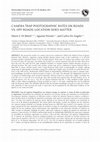
We present the results of a camera trap survey conducted in 2008 in the Atlantic Forest of Iguazú... more We present the results of a camera trap survey conducted in 2008 in the Atlantic Forest of Iguazú National Park, Misiones, Argentina, testing whether placing camera traps on dirt roads/trails or in off-road locations produce important biases in the recorded species. Seven pairs of camera trap stations were active for 26.6 ± 8.9 days; for each pair, one station was located on a narrow unpaved road and the other about 50 m from the road. We used the first order Jackknife estimator to compare species richness between on-road vs. off-road locations. We used records from another camera trap survey conducted at Iguazú National Park in 2006-2007 to assess whether species with a high Road-use Index (ratio of photographs of animals walking along roads to photographs of animals crossing the roads) had a higher ratio of records on roads/off road sta-tions in the 2008 survey. Multivariate ANOVA based on dissimilarities (ADONIS) was used to compare mam-mal assemblages recorded at stations locate...
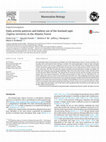
Mammalian Biology - Zeitschrift für Säugetierkunde, 2014
We studied the daily activity pattern and habitat use of the lowland tapir Tapirus terrestris and... more We studied the daily activity pattern and habitat use of the lowland tapir Tapirus terrestris and their relationship with environmental and anthropic variables. We used photographic records of tapirs obtained during five camera-trap surveys conducted in three areas of the Atlantic Forest of Argentina that differ in their protection against poaching. The daily activity pattern was analyzed with circular statistics and linear regression. The effect of protection against poaching and environmental variables on habitat use of tapirs was analyzed using occupancy modeling. Tapirs were nocturnal all year round, with 89% of the records between 1800 h and 0700 h. The proportion of nocturnal records and the recording rate did not change with mean daily temperature. The daily activity pattern of tapirs was not affected by the sex of the individuals, the lunar cycle or the protection level of the area. The probability of detecting tapirs increased with the distance to the nearest access points for poachers and decreased with the abundance of bamboo in the understory and increasing trail width. The probability of use of an area by tapirs increased with increasing protection against poaching and distance to the nearest access points for poachers. These results suggest that poaching is one of the factors with significant effect on habitat use by tapirs but not on their daily activity patterns.

Oryx, 2008
A g u s t Í n P a v i o l o , C a r l o s D a n i e l D e A n g e l o , Y a m i l E d g a r d o D... more A g u s t Í n P a v i o l o , C a r l o s D a n i e l D e A n g e l o , Y a m i l E d g a r d o D i B l a n c o and M a r i o S a n t i a g o D i B i t e t t i Abstract The Green Corridor of Argentina and Brazil is the largest forest remnant of the Upper Paraná Atlantic Forest. The jaguar population of this region is highly fragmented and reduced. To assess the status of the subpopulation of jaguars of the Green Corridor we conducted four camera-trap surveys in three sites with different levels of protection. At Urugua-í (34 stations, 1,495 trap-days) we recorded one individual (minimum density 5 0.12-0.33 per 100 km 2 ). At Yabotí Biosphere Reserve (42 stations, 1,871 trap-days) we recorded two individuals (minimum density 5 0.11-0.25 per 100 km 2 ). At Iguazú National Park we conducted two surveys. In 2004 (39 stations, 1,839 trap-days) we recorded four adult individuals, estimating a density of between 0.49 -0.16 and 1.07 -0.33 per 100 km 2 . In 2006, we increased the area sampled (47 stations, 2,059 trap-days) and recorded 11 adult individuals, estimating a density of 0.93 -0.2 to 1.74 -0.34 per 100 km 2 .
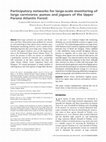
Oryx, 2011
Most large carnivores are secretive and threatened, and these characteristics pose problems for r... more Most large carnivores are secretive and threatened, and these characteristics pose problems for research on, and monitoring of, these species across extensive areas. Participatory monitoring, however, can be a useful tool for obtaining long-term data across large areas. Pumas Puma concolor and jaguars Panthera onca are the largest predators in the threatened Upper Paraná Atlantic Forest. To survey the presence of these two species we established a participatory network of volunteers and a partnership with researchers in the three countries that share the Upper Paraná Atlantic Forest (Argentina, Brazil and Paraguay). We trained participants in simple methods of collecting faeces and track imprints of large felids. Between 2002 and 2008 . 100 volunteers helped with monitoring, obtaining 1,633 records identified as pumas or jaguars across c. 92,890 km 2 . We confirmed jaguar presence in a large section of the Misiones Green Corridor in Argentina and in the largest protected areas of Brazil and Paraguay. Pumas exhibited a wider distribution, being recorded throughout Misiones province in Argentina and in some areas of Brazil and Paraguay where jaguars were not detected. Both species, and especially jaguars, were detected mainly in the few remaining medium and large forest fragments in this Forest. Although these carnivores are often in conflict with local people, their charisma and cultural significance makes them flagship species that motivated the participation of volunteers and institutions. Participatory monitoring allowed coverage of a vast area at relatively low cost whilst enhancing collaborative management policies among people and institutions from three countries.
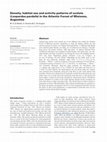
Journal of Zoology, 2006
Camera-trap surveys were carried out at two different sites within the Atlantic Forest of Misione... more Camera-trap surveys were carried out at two different sites within the Atlantic Forest of Misiones province, Argentina, to study the density, habitat use and activity patterns of ocelots. At Urugua-´ı Provincial Park, 17 different individuals were captured (nine females, six males, two of unknown sex) during a 3-monthlong survey (34 camera stations, 1409 trap days). At Iguazu´National Park, 34 different individuals were trapped (20 adult females, nine adult males, two subadult females and three of unknown sex) during the survey (39 sampling stations, 1631 trap days). Population density estimates ( AE SE) for Urugua-´ı, in an area of between 150 and 259 km 2 (depending on the buffer used to estimate the area effectively sampled), range from 7.7 AE 1.4 to 13.4 AE 2.6 individuals  100 km À2 , whereas at Iguazu´, in an area of between 275 and 428 km 2 , a population density of between 12.8 AE 2.7 and 20.0 AE 4.2 individuals  100 km À2 was estimated. Minimum observed range estimates for individuals with 43 capture sites range from 3.19 to 37.09 km 2 for four males and from 4.17 to 7.11 km 2 for three females, but underestimate the true home range size. Ocelots were captured more frequently along old roads than on new trails opened with machetes. Ocelots were captured more frequently at night than during the day and reduce their use of roads and trails during the week previous to and during full moon nights, a behavior previously reported for Amazonian ocelots. Population density estimates for ocelots in the Upper Paran´a Atlantic Forest ecoregion are lower than those at other neotropical sites. The whole Green Corridor contains a population of about 1280 individuals. This estimate should bring our attention to the larger cats (pumas and jaguars) that live at lower population densities because the future of their local populations is compromised if protected areas are not urgently created and properly managed.

Journal of Zoology, 2011
We studied the density of a Geoffroy's cat Leopardus geoffroyi population in a semiarid scrubland... more We studied the density of a Geoffroy's cat Leopardus geoffroyi population in a semiarid scrubland of Argentina, by comparing density estimates obtained during camera-trapping surveys in a national park and in nearby cattle ranches in 2006 and 2007-2008. Overall, we obtained 247 pictures of Geoffroy's cats. The density (mean AE SE) of the species at the park ranged from 1.2 AE 0.3 to 2.9 AE 1.4 individuals km À2 , depending on the buffer applied, whereas density estimates at ranches were on average 32% lower. Only 11% of the Geoffroy's cats identified in 2006 could still be detected in the area 2 years later, indicating that there was a high turnover of individuals in this population. The sex ratio (M:F) estimated during both surveys at the park was 1:1.4, whereas at the ranches it was 1:0.8. The capture success of sympatric pampas cats Leopardus colocolo and jaguarundis Puma yagouaroundi was o0.3 records per 100 trap-days, and no evidence of these species was found in the ranches. Geoffroy's cats seem to be tolerant to some degree of habitat alteration produced by livestock management, and the numerical response of this species in ranches could be largely the result of human persecution and the effects of livestock management on the habitat structure and prey base.
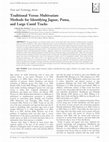
Journal of Wildlife Management, 2010
The jaguar (Panthera onca) and puma (Puma concolor) are the largest felids of the American Contin... more The jaguar (Panthera onca) and puma (Puma concolor) are the largest felids of the American Continent and live in sympatry along most of their distribution. Their tracks are frequently used for research and management purposes, but tracks are difficult to distinguish from each other and can be confused with those of big canids. We used tracks from pumas, jaguars, large dogs, and maned wolves (Chrysocyon brachyurus) to evaluate traditional qualitative and quantitative identification methods and to elaborate multivariate methods to differentiate big canids versus big felids and puma versus jaguar tracks (n 5 167 tracks from 18 zoos). We tested accuracy of qualitative classification through an identification exercise with field-experienced volunteers. Qualitative methods were useful but there was high variability in accuracy of track identification. Most of the traditional quantitative methods showed an elevated percentage of misclassified tracks ( L 20%). We used stepwise discriminant function analysis to develop 3 discriminant models: 1 for big canid versus big felid track identification and 2 alternative models for jaguar versus puma track differentiation using 1) best discriminant variables, and 2) size-independent variables. These models had high classification performance, with ,10% of error in the validation procedures. We used simpler discriminant models in the elaboration of identification keys to facilitate track classification process. We developed an accurate method for track identification, capable of distinguishing between big felids (puma and jaguar) and large canids (dog and maned wolf) tracks and between jaguar and puma tracks. Application of our method will allow a more reliable use of tracks in puma and jaguar research and it will help managers using tracks as indicators of these felids' presence for conservation or management purposes.
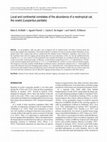
Journal of Tropical Ecology, 2008
As top predators, wild cats play a key ecological role in tropical forests, but little is known a... more As top predators, wild cats play a key ecological role in tropical forests, but little is known about the factors that regulate their abundance. This study looked for correlates of ocelot (Leopardus pardalis) abundance at two spatial scales. First, camera-trap surveys conducted in the Atlantic Forest of Misiones, Argentina, were used to test the hypothesis that selective logging and poaching affect the local abundance of this cat. Second, published density estimates (N = 21) were used to test the hypothesis that rainfall and latitude are correlated with the abundance of ocelots across their continental range. In Misiones, ocelot densities ranged from 4.96 ± 1.33 individuals per 100 km 2 in the intensely logged and hunted areas to 17.6 ± 2.25 individuals per 100 km 2 in areas with low human impact. The frequency of records, number of individuals recorded per station, and density estimates were 2-3 times higher in areas with relatively low levels of logging and poaching. At a continental scale, ocelot densities decrease with latitude and increase with rainfall. Primary productivity seems to determine the abundance of wild cats across their range, but at a local scale their abundance may be affected by logging and poaching or by competition with other species.
Journal of Mammalogy, 2009
Journal of Mammalogy, 2009
Diversity and Distributions, 2011
Aim Jaguars and pumas, being similar in size and behaviour, are the largest felids of the Neotrop... more Aim Jaguars and pumas, being similar in size and behaviour, are the largest felids of the Neotropics. However, pumas appear to be more resistant to human impacts. Our objective was to compare the response of both species with human impacts at a regional scale in a highly modified region where both species had continuous distribution in the past.
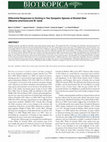
Biotropica, 2008
Hunting by humans may affect the abundance and activity patterns of game species. We examined the... more Hunting by humans may affect the abundance and activity patterns of game species. We examined the effect of hunting on the abundance and activity patterns of sympatric red brocket deer Mazama americana and dwarf brocket deer M. nana. We conducted four camera-trap surveys (158 sampling stations, 10,244 trap-days, total area sampled 1200 km 2 ) in three areas within the Atlantic Forest of Misiones, Argentina, that differ in protection and hunting pressure. We used logistic regression and tests of independence to evaluate if protection, hunting pressure, and other independent variables affect the probability of recording each species and their recording rate. We used the Mardia-Watson-Wheeler test to examine if the daily activity pattern differs between species and changes with hunting pressure. Red brocket deer were more frequently recorded (397 records, 58% of stations) than dwarf brocket deer (100 records, 37% of stations). The probability of recording red brockets was higher in areas with better protection and increased with the distance to the main accesses used by poachers. The probability of recording dwarf brockets was higher in areas with low protection. Red brockets were more nocturnal than dwarf brockets, a difference that may reduce interspecific competition. However, red brockets were more diurnal in the best-protected areas, suggesting that they can adjust their activity to local hunting pressure. Hunting has opposite effects on the abundance of these deer and may facilitate their coexistence. Hunting should be carefully controlled or managed to ensure the conservation of these little known species.
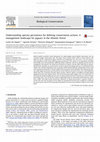
Biological Conservation, 2013
Habitat models constitute useful instruments for understanding species-habitat interactions and c... more Habitat models constitute useful instruments for understanding species-habitat interactions and can constitute helpful conservation tools. The Upper Paraná Atlantic Forest (UPAF) of South America still holds the world's southernmost jaguar (Panthera onca) population. Our aims were: (i) to test several a priori hypotheses on the factors affecting jaguar persistence in this region, (ii) to map habitat suitability and identify areas with potentially conflicting habitat conditions, and (iii) to identify priority areas for management and improve the conservation initiatives for jaguars and the UPAF. Following an information-theoretic approach, we used presence records of jaguars and pseudo-absences in generalized linear models. We structured hypotheses into two groups which demand different management actions: land cover and human persecution. The best model of each group was used to develop a two-dimensional habitat model. Jaguar persistence was favoured by current and historical native forest cover, and hindered by human land uses. Protection favoured jaguar presence whereas human accessibility and high human population density had negative effects. The two-dimensional model suggests that <8% (20,670 km 2 ) of the landscape represents potential core areas for jaguars (good land-cover characteristics and low human persecution) and 11.8% (32,563 km 2 ) stands as potentially attractive sinks where good land-cover conditions conflict with high human persecution. Reduction of human persecution is urgently needed to increase the core areas for jaguars in this region, but improvement of land-cover conditions is important for sustaining the connectivity among jaguar populations that seem to be isolated in different areas of the UPAF.

Acta Oecologica, 2010
Carnivores have been used as a model to understand the effects of competition in community struct... more Carnivores have been used as a model to understand the effects of competition in community structure. Behavioral mechanisms that facilitate species coexistence have been poorly explored and may explain the lack of community-wide morphological character displacement in some carnivore assemblages. We use the results of large-scale and intensive camera-trap surveys conducted in the Atlantic Forest of NE Argentina between 2003 and 2008 to describe the spatial patterns of detection and the daily pattern of records of the six wild cat species present in the region (jaguar Panthera onca, puma Puma concolor, ocelot Leopardus pardalis, jaguarundi Puma yagouaroundi, margay Leopardus wiedii, and oncilla Leopardus tigrinus). We use these patterns to generate hypotheses about behavioral differences that may facilitate species coexistence. The larger species were more frequently recorded in the better-protected areas, probably as a result of anthropogenic effects (poaching of cats and their prey). Competitive release from ocelots and jaguarundis may explain why the oncilla and the margay showed the opposite pattern. Morphologically similar species had the most contrasting activity patterns: the margay was exclusively nocturnal and the jaguarundi diurnal. The other species were cathemeral, but alternated their peaks of activity in relation to the relative order of their body weights. The contrasting temporal patterns observed and the ability of pumas and oncillas to adjust their activity patterns to local conditions may facilitate the coexistence of these cat species and explain the lack of character displacement in this assemblage.
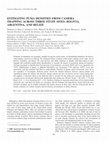
Journal of …, 2008
Estimates of abundance are extremely valuable for species conservation, yet determining abundance... more Estimates of abundance are extremely valuable for species conservation, yet determining abundance for elusive, wide-ranging, carnivores is difficult. We estimated density of pumas using remote cameras across study sites in Bolivia, Argentina, and Belize. We used obvious and subtle markings to identify individual pumas in photographs and conducted double-blind identifications to examine the degree of agreement among investigators. Average agreement on identification between pairs of investigators was nearly 80.0% and 3-way agreement was 72.9%. Identification of pumas as different individuals was uncommon (7.8% pairwise, 0.69% 3-way disagreement) with the remainder described as unidentifiable. Densities of pumas varied consistently from site to site regardless of investigator. Bolivian pumas moved the shortest distances between camera stations and Argentinean pumas the longest, but distances among cameras and area covered by surveys varied among sites. We applied a correction factor to the Bolivian data to account for the small area surveyed and found that, averaged across investigator, Bolivia had significantly more pumas per 100 km 2 (mean 6 SD; 6.80 6 1.5) than Belize (3.42 6 1.3) or Argentina (0.67 6 0.2). Numbers of pumas in Argentina match those of low-density North American sites, and those for Belize are consistent with the Pantanal and high-density North American sites. Densities of pumas can be reliably estimated with remote cameras for these sites, and our work presents the 1st density estimates for Central America and for forested environments in South America.

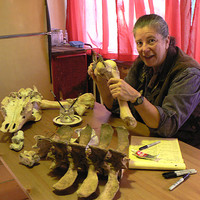





Uploads
Papers by Agustín Paviolo